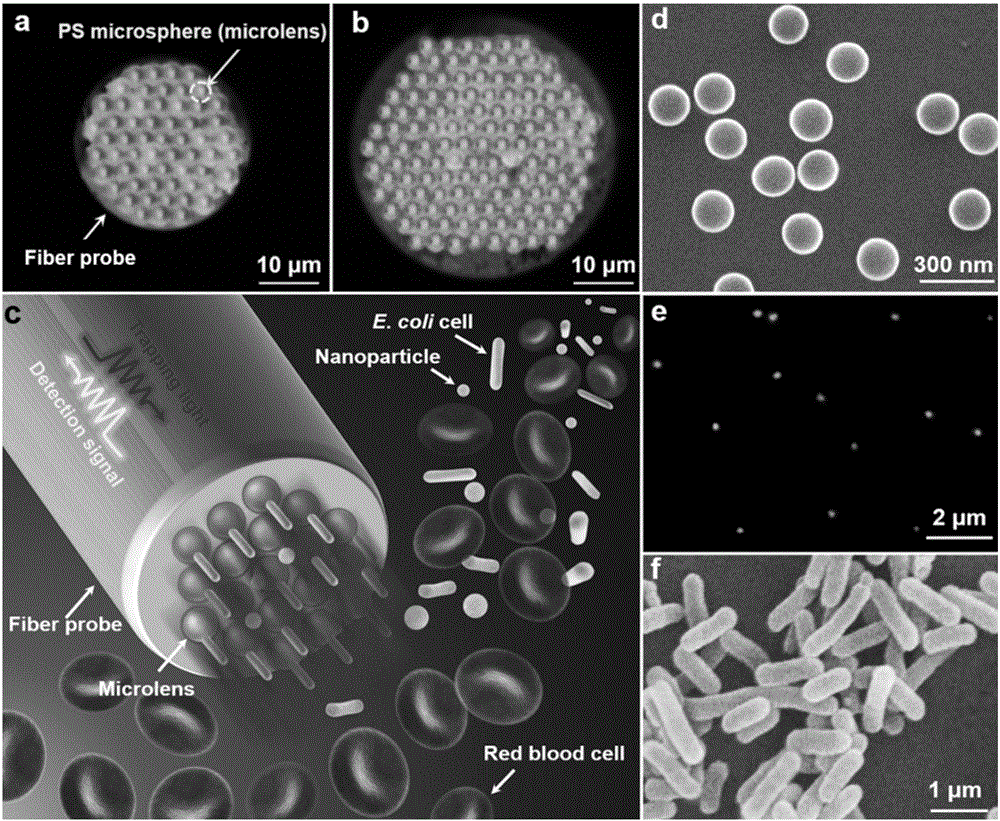Optical capturing and detecting device and method based on quantum photon nano-jet array
A photonic nanometer and optical trapping technology, which is applied in the optical field to achieve high-efficiency optical trapping and detection, flexible operation, and simple device structure.
- Summary
- Abstract
- Description
- Claims
- Application Information
AI Technical Summary
Problems solved by technology
Method used
Image
Examples
preparation example Construction
[0066] The specific preparation method is as follows: After stripping a 2 cm coating layer in the middle of the optical fiber with an optical fiber stripper, insert it into a glass capillary to protect the optical fiber. The inner diameter of the capillary is 0.9 mm and the wall thickness is 0.1 mm. , with a length of 12 cm, and then place the bare optical fiber parallel to the outer flame above the alcohol lamp, let it stand for about 40 seconds until the optical fiber is melted, and draw the molten part with the help of hands at a speed of 2 mm per second. The fiber is 45 microns long and about 1.6 mm in length. Then take the fiber away from the flame, let it stand at room temperature for 2 minutes, and finally cut off the thinned part with a fiber cutter.
[0067] The diameter of the fiber optic probe can be adjusted by the speed of drawing and the position of cutting.
[0068] Step 2: Make Microlens Array
[0069] Using photophoretic technology, a regular two-dimensional ...
Embodiment
[0079] The microlens used in this embodiment is a polystyrene microsphere with a diameter of 3 microns, which has a high refractive index and low optical absorption, and is easy to generate photon nanojet.
[0080] like figure 2 As shown in (a), 60 microlenses are assembled on a fiber optic probe with a diameter of 28 μm.
[0081] With larger diameter fiber optic probes, it is possible to assemble a larger range of microlens arrays, such as figure 2 As shown in (b), 130 microlenses were assembled on a fiber optic probe with a diameter of 45 μm.
[0082] When the laser light passes through the fiber optic probe, each microlens will strongly converge the light, and behind the microlens will generate bundles of parallel sub-wavelength beams, called nanojet arrays, which can be used for capture and detection Nanoparticles and subwavelength cells, such as figure 2 (c) The schematic diagram shows that multiple nanoparticles and E. coli cells in the blood are selectively trappe...
PUM
| Property | Measurement | Unit |
|---|---|---|
| Diameter | aaaaa | aaaaa |
| Diameter | aaaaa | aaaaa |
| Diameter | aaaaa | aaaaa |
Abstract
Description
Claims
Application Information
 Login to View More
Login to View More - R&D
- Intellectual Property
- Life Sciences
- Materials
- Tech Scout
- Unparalleled Data Quality
- Higher Quality Content
- 60% Fewer Hallucinations
Browse by: Latest US Patents, China's latest patents, Technical Efficacy Thesaurus, Application Domain, Technology Topic, Popular Technical Reports.
© 2025 PatSnap. All rights reserved.Legal|Privacy policy|Modern Slavery Act Transparency Statement|Sitemap|About US| Contact US: help@patsnap.com



